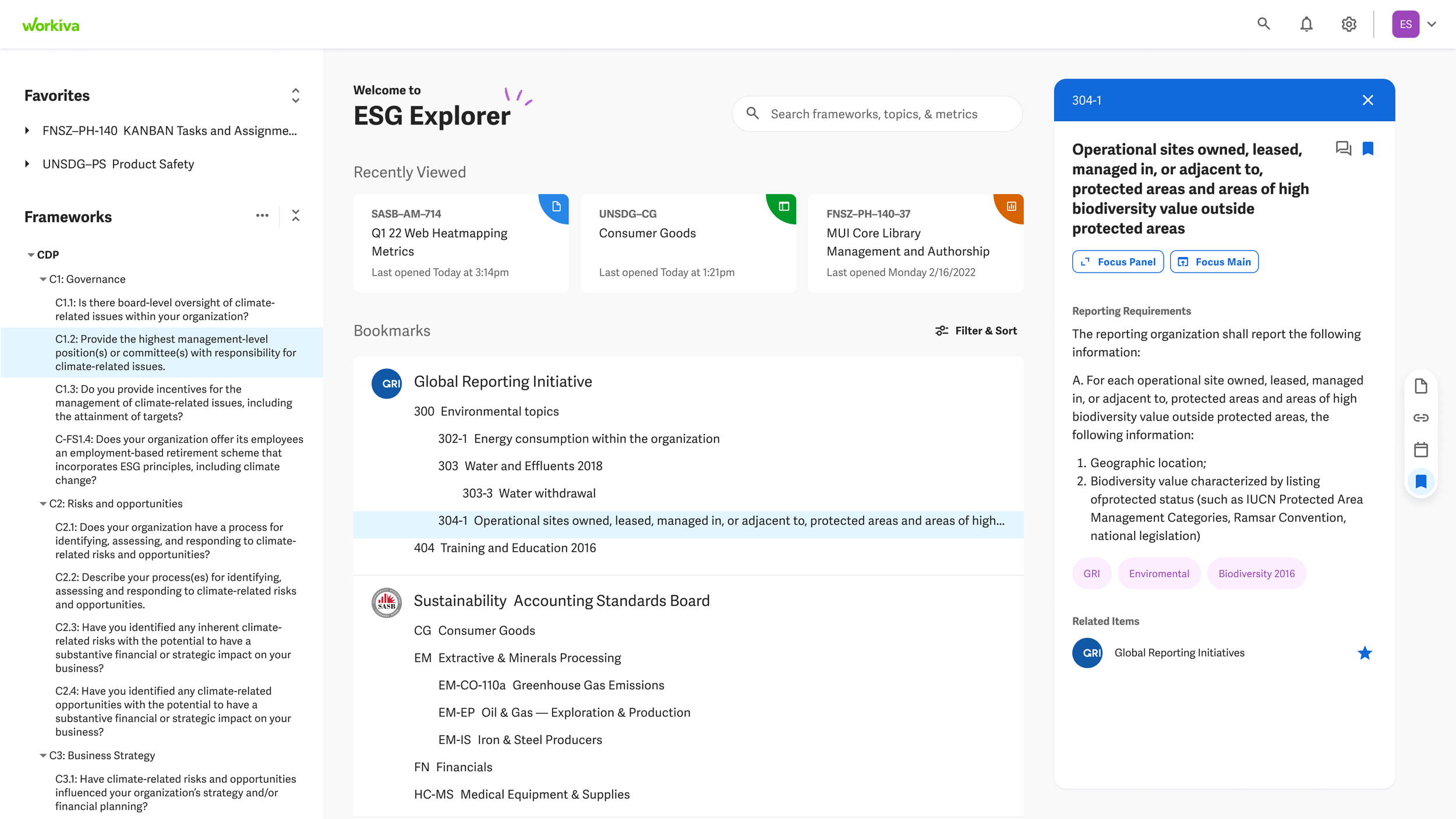DATA EXPLORER
The ESG Explorer was the foundational entry point to Workiva's Sustainability Platform, designed to solve the core challenge of ESG reporting: making sense of the fragmented, overlapping "alphabet soup" of global regulatory frameworks. As lead designer, I created a knowledge graph research tool that transformed disconnected compliance requirements into an intuitive, interconnected system.
Discovery
The Challenge
Organizations attempting to implement ESG reporting faced several critical obstacles:
Framework Proliferation: Dozens of reporting frameworks (SASB, GRI, TCFD, EU CSRD, etc.) with overlapping requirements
Inconsistent Formats: Each framework presented requirements in different structures and terminology
Hidden Connections: Significant overlap between frameworks was invisible to users, creating duplicate work
Discovery Limitations: No clear path to identify which requirements applied to specific organizations
Knowledge Transfer: Difficulty translating research findings into actionable reporting metrics
Design Approach
1. Normalizing the Regulatory Landscape
Challenge: Diverse frameworks used inconsistent structures and terminology.
Solution: Created a unified information architecture that normalized requirements across frameworks.
Developed standardized metadata schema for consistent representation
Designed flexible container system adapting to framework-specific structures
Created visual hierarchy that preserved original framework organization while enabling cross-framework comparison
Implemented consistent terminology mapping to unify diverse vocabulary across sources
2. Relationship-Driven Knowledge Graph
Challenge: Critical relationships between requirements remained hidden in traditional hierarchical systems.
Solution: Designed a graph database-powered relationship model revealing connections between requirements.
Collaborated with data architects to define multi-dimensional relationship taxonomy
Created intuitive visualization of requirement relationships across frameworks
Designed interactive "You might also care about" recommendation panels that surfaced relevant connections
Implemented relationship filters to focus on specific connection types (similar to, prerequisite for, satisfies)
3. Research Workflow Integration
Challenge: Research findings needed to seamlessly transition into reporting program development.
Solution: Created end-to-end workflow connecting research to program implementation.
Designed bookmarking system for collecting relevant requirements
Created custom collections functionality for organizing requirements by theme
Implemented export pathways to transition selected requirements into Program metrics
Developed comparison tools for assessing requirements across multiple frameworks
4. Visual Search & Discovery
Challenge: Traditional search couldn't adequately navigate complex interconnected requirements.
Solution: Designed multi-modal search experience tailored to ESG research workflows.
Created faceted search with industry, topic, and framework filters
Implemented specialized keyword mapping for ESG terminology
Designed visual browsing interface for framework exploration
Developed side-by-side comparison view for evaluating related requirements
Technical Execution
Graph Database Integration: Collaborated with engineering to design optimal data structures
Dynamic Visualization: Created responsive interface for displaying complex relationships
Metadata Enhancement: Developed system for continuous framework updates and relationship refinement
Memory Management: Optimized interface for handling thousands of interconnected nodes
User Impact
Explorer fundamentally transformed how organizations approach ESG reporting:
Research Efficiency: Reduced framework analysis time from weeks to days
Requirement Discovery: Increased identification of relevant requirements by over 40%
Cross-Framework Alignment: Enabled organizations to satisfy multiple frameworks simultaneously
Implementation Clarity: Provided clear pathway from requirements to metric development
Regulatory Insight: Delivered unprecedented visibility into the evolving ESG landscape
Business Outcomes
Explorer served as the primary entry point to the Sustainability Platform, delivering significant business value:
Market Differentiation: Established Workiva as having unique insight into ESG complexity
Sales Enablement: Provided compelling demonstration of value during sales process
Customer Acquisition: Attracted new enterprise clients seeking regulatory clarity
Platform Adoption: Created natural pathway to Program implementation
Expert Positioning: Reinforced Workiva's thought leadership in ESG reporting
Design Innovation
The Explorer introduced several innovative patterns that influenced both Workiva's design system and the broader industry:
Knowledge Graph Navigation: New paradigm for exploring interconnected regulatory content
Relationship Visualization: Interactive methods for displaying non-hierarchical connections
Framework Normalization: Unified presentation of diverse regulatory structures
Recommendation Systems: Contextual suggestion patterns for complex information spaces
Research-to-Implementation Workflow: Seamless transition from discovery to action
Explorer established the foundation of Workiva's Sustainability Platform success, demonstrating how thoughtful information architecture and relationship design could transform overwhelming complexity into intuitive clarity for enterprise users.








